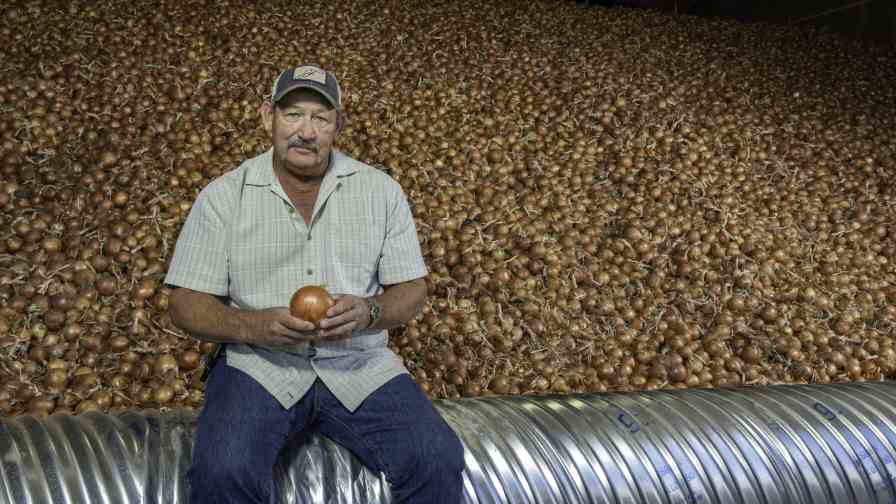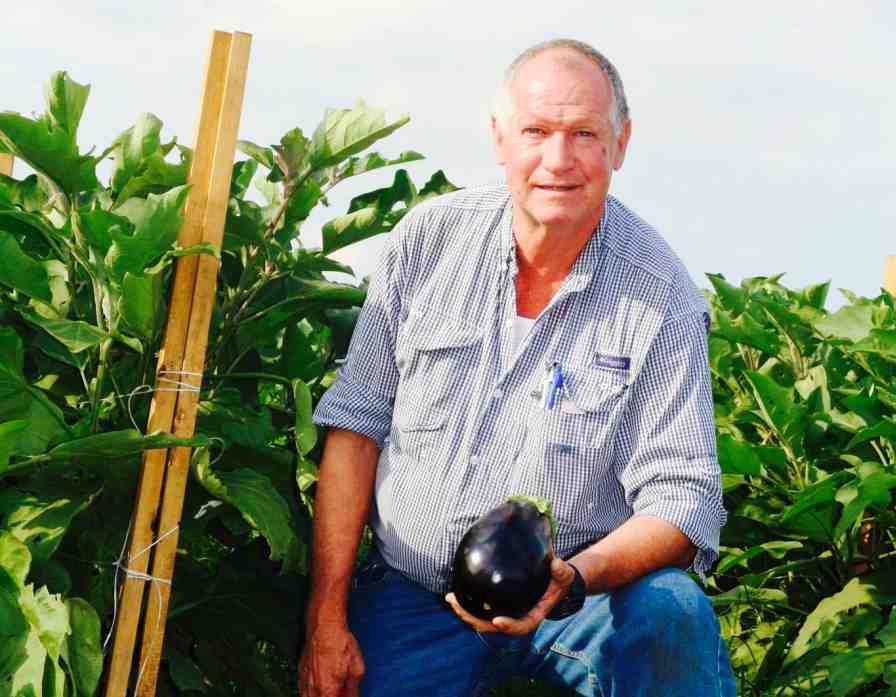How To Maximize Water Efficiency On Your Vegetable Farm
Water management is a complex puzzle. In spite of the recent rain in the West, strategies that employ conservation are still critical. In the East, and Florida in particular, there are regulations pertaining to water use that must be followed, so growers need to be mindful of how they use this precious resource.
I had the opportunity to speak with a couple of growers on their irrigation methods and find out some helpful tips you might be able to incorporate on your farm.
Each grower faced different issues, but the outcome was the same: They maximized their water usage.
Fagerberg Produce, Eaton, CO

Rod Weimer of Fagerberg Produce says byi using drip irrigation, the farm has reduced the amount of water it uses by 40%.
Photo credit: Robert D. Jones
A grower/packer/shipper of about 1,300 acres of yellow, red, and white onions, along with winter wheat, pinto beans, and field corn, Fagerberg Produce has figured out how to produce a high-yielding onion crop and save water at the same time. Rod Weimer, Farm Manager, recalls a time in the early 2000s when faced with drought conditions, the farm didn’t have to fallow any land — thanks to drip irrigation technology.
Back in the late ’90s, the owner of the company, Lynn Fagerberg, who Weimer says has always been innovative and supportive of adding new technology, realized the farm would have to make a change regarding water usage. Municipalities were growing and using more water. And because of drought conditions, farm efficiencies needed to be increased, Weimer says.
“We started researching drip irrigation,” he recalls. “In 1998, we installed the first 200 acres.” Today, the farm employs Netafim for its planning design needs and uses the company’s drip tape and filtration equipment.
Since it began using drip, the farm has reduced the amount of water it uses by 40%, and went from using 3.5 acre feet of water when flood irrigating to 1.6 acre feet using drip. “The savings can actually be greater than 40%, depending on how hot it gets,” Weimer adds.
Precision Irrigation
 Today, the use of drip tape and GPS are critical to the farm’s water management. And attention to detail is the only way to be successful with those tools.
Today, the use of drip tape and GPS are critical to the farm’s water management. And attention to detail is the only way to be successful with those tools.
“The biggest aspect to be efficient in is the design of your system,” he says. “If the irrigation system isn’t designed properly, it is not going to work properly. You have to lay it out like a sprinkler on your lawn and make sure all your angles are met before you put it in the ground.”
Weimer should know. Last year, he received recognition for his accomplishments when he was named 2015 Precision Agriculture Farmer of the Year by the Precision Ag Institute, which is managed by the Agribusiness Group of Meister Media Worldwide. Dr. Raj Kholsa, the Colorado State University professor who nominated Weimer for the award, said Fagerberg is “the first Colorado farm to install sub-surface drip irrigation and then the first to purchase autopilot GPS to install drip tape within sub-centimeter accuracy.”
Today, with help from an app on his smartphone, Weimer can check rates, start and stop fertilizer, and water from virtually anywhere, thanks to a fully automated drip irrigation system. He is quick to add, however, that by no means is drip irrigation a turnkey operation where you can start it up and walk away.
Monitoring, Testing Lead To Savings
Monitoring may be essential to the success of the system, but Weimer says there also is a tremendous labor savings as no one is in the field irrigating, changing water-setting tubes, cultivating, cleaning ditches, etc. The farm is saving $300 to $400 per acre on labor and fuel combined.
Fertilizer also is applied to crops via drip lines, and Weimer says they have decreased nitrogen use by 50% as the nutrient is applied to the root zone.
The top priority for Fagerberg Produce now, however, is taking better care of its most precious commodity: water. By using drip, they have removed runoff issues and water and fertilizer are precisely placed to nourish the plant.
“We are giving the plant exactly what it needs, when it needs it,” he says.
3 Tips To Help You Conserve Water
Rod Weimer, Farm Manager at Fagerberg Produce in Colorado, has been using drip irrigation for nearly 20 years, which has helped the operation save a tremendous amount of water. For those of you looking to switch to drip, Weimer has a few pointers to ponder.
Consider the layout of your farm. “We don’t have a lot of hills, so we have more uniform irrigation,” he says. “It’s important to give careful thought to land prep, the design of your system, and management.”
1 Land prep: Today’s improved technology allows you to have some hilly conditions, as pressure-compensated emitters will help you get your field irrigated as evenly as possible. Weimer adds, however, you should look to reduce any dips in the field and level it before installing drip.
2 System design: Design your system based on a clear understanding of the water resources you’re working with. “You have to set it up [your irrigation system] in zones, so you have to make your zones appropriate to how much water you have.”
3 Management: Weimer also cautions growers to manage their moisture. “Technology has changed and we use tensiometers and irrigate according to what those tell us,” he says. As a result, irrigation takes place on an as-needed basis.
C&B Farms, Clewiston, FL

Chuck Obern of C&B Farms in Clewiston, FL, says all farms are unique based on their topography, irrigation methodology, and crops they grow.
Some crops, however, simply were not economically viable to use drip. That is what spurred him to look into a tailwater recovery system, which is a facility that not only collects and stores water, but also transports irrigation tailwater for reuse on the farm.
In 2005, Obern installed his first system, allowing him to tap into available surface water to augment the wells he has on the farm, as well as reduce phosphorus loading or runoff. In 2007 and 2008, C&B Farms did another tailwater recovery for its 550-acre organic farm that also allowed the farm to reduce energy costs for irrigation.
Reduce Phosphorus Discharge
Phosphorus from runoff was a big concern as it can impact the water quality in some parts of the Everglades, and C&B Farms is located at the head waters of the Everglades, Obern says.
He cites the Everglades Forever Act, which includes directives to reduce excessive levels of phosphorus, as part of the reason he opted to get involved with various government agencies to work on tailwater recovery. C&B Farms is recognized as one of the first in South Florida to take steps to decrease the amount of phosphorus that potentially could impact water quality in the Everglades.
Taking phosphorus discharge a step further, Obern opted to take part in another project on his organic farm where aluminum sulfate was added to water discharging into a canal. The aluminum sulfate combines with the phosphorus to make aluminum phosphate. Because the aluminum phosphate has very low solubility, it precipitates out of the water, he says.
“Using a computer to measure the volume of water, we inject the aluminum sulfate into the water and then we used a 6-acre holding pond to allow the aluminum phosphate to settle out before the water goes into the drainage system. This project allowed us to demonstrate more than a 90% reduction in soluble phosphorus discharge,” he explains.
Understand Water Use Permits
One of the underlying reasons for controlling phosphorus discharge and using tailwater recovery systems is to be in compliance with the law in the Sunshine State. In Florida, the state owns the water, even if it is on private property, Obern says. As a result, he is required to have a permit to use the water on his land.
In addition to the water-use permit that governs how much water he can withdraw for irrigation purposes, Obern also is required to have an Environmental Resource Permit (ERP). For the ERP, he must describe how he controls the discharge of water, which includes the building of water retention ponds.
A Money-Saving System
As it turned out, conforming to the law actually saved Obern money. By implementing tailwater recovery systems, he cut his energy consumption in half. Obern says he irrigates eight months of the year and uses tailwater about 65% of the time, saving about $4,000 a week.
How was he able to reduce energy consumption? He says it all has to do with physics.
“In a well, the aquifer water table we are pumping from gets up to around 40 feet below the surface. You have to pull water up 40 feet, which requires a lot of energy. Whereas on the surface water, we are only pulling water up an average of 5 feet, so we are saving money in fuel costs,” Obern explains.
He also mentions that of the numerous government projects he participated in, the government footed the bulk of the bill, between 80% and 90%.
“We joined with the government to figure out the best methodologies to accomplish these tasks, both for the government and me as a farmer,” he says. “We came up with methodologies that worked for both sides.”
3 Takeaways On Water Conservation And Irrigation Management
Chuck Obern of C&B Farms in Clewiston, FL, offers some advice for those looking to become better at water conservation and irrigation management.
1 All farms are unique based on their topography, irrigation methodology, and crops they grow. Because of the uniqueness, it requires the grower to be innovative and think about possible methods for better water use.
2 Be innovative in water conservation. You have to work with the government and participate with USDA’s Natural Resources Conservation Service. “Be educated enough to be able to respond to all the different impacts you will have [working with the government],” Obern explains.
3 Work through the details, especially as they pertain to regulations. Obern mentions the Food Safety Modernization Act and how it comes into play with using tailwater recovery and surface water. For the most part, he says well water is the preferred choice, not surface water.
“In responding to that, we are working with University of Florida researchers showing that the surface water doesn’t touch the crop and instead seeps through the dirt. Therefore, the water that needs to be tested for food safety purposes should be the seep water that touches the roots of the plants,” he says. “We developed a methodology about five years ago for verification with the University of Florida on the efficacy of reducing possible pathogen contamination of the crops we grow.”
HAVE AN EYE FOR PRECISION AG?
To learn more about the types of technology Fagerberg Produce is employing, make plans to attend the inaugural Precision Ag Vision Conference, Oct. 18-20, 2016
in Phoenix, AZ.
For details, visit PrecisionAgVision.com.










